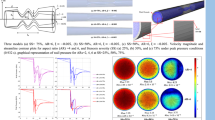Abstract
This paper explores the mathematical model for couple stress fluid flow through an annular region. The above model is used for studying the blood flow between the clogged (stenotic) artery and the catheter. The asymmetric nature of the stenosis is considered. The closed form expressions for the physiological parameters such as impedance and shear stress at the wall are obtained. The effects of various geometric parameters and the parameters arising out of the fluid considered are discussed by considering the slip velocity and tapering angle. The study of the above model is very significant as it has direct applications in the treatment of cardiovascular diseases.
Similar content being viewed by others
References
Sarkar, A. and Jayaraman, G. Nonlinear analysis of oscillatory flow in the annulus of an elastic tube: application to catheterized artery. Physics of Fluids, 13, 2901–2911 (2001)
Rudolf, R. and Paul, S. L. The fluid mechanics of the ureter with an inserted catheter. Journal of Fluid Mechanics, 46, 625–630 (1971)
Young, D. F. and Tsai, F. Y. Flow characteristics in models of arterial stenosis I, steady flow. Journal of Biomechanics, 6, 396–402 (1973)
Shukla, J. B., Parihar, R. S., and Rao, B. R. P. Effect of stenosis on non-Newtonian flow of the blood in an artery. Bulletin of Mathematical Biology, 42, 283–294 (1980)
Srinivasachary, D. and Srikanth, D. Flow of micropolar fluid through catheterized artery-a mathematical model. International Journal of Biomathematics, 5, 1250019 (2012)
Mortazavinia, Z., Zare, A., and Mehdizadeh, A. Effects of renal artery stenosis on realistic model of abdominal aorta and renal arteries incorporating fluid-structure interaction and pulsatile non-Newtonian blood flow. Applied Mathematics and Mechanics (English Edition), 33, 165–176 (2012) DOI 10.1007/s10483-012-1541-6
Mekheimer, Kh. S. and El Kot, M. A. The miropolar fluid model for blood flow through a stenotic arteries. International Journal of Pure and Applied Mathematics, 36, 393–405 (2007)
Stokes, V. K. Couple stresses in fluids. Physics of Fluids, 9, 1709–1716 (1966)
Srinivasachary, D. and Srikanth, D. Effect of couple stress on the flow in a constricted annulus. Archive of Applied Mechanics, 78, 251–257 (2008)
Srivastava, L. M. Flow of couple stress fluid through stenotic blood vessels. Journal of Biomechanics, 18, 479–485 (1985)
Srikanth, D. Steady polar fluid flow in a multiple constricted annulus-catheter effects. International Journal of Applied Mathematics and Mechanics, 9, 17–28 (2013)
Maiti, S. and Misra, J. C. Peristaltic transport of a coupe stress fluid: some applications to hemodynamics. Journal of Mechanics in Medicine and Biology, 12, 1250048 (2012)
Devajyoti, B. and Uday, S. C. Pulsatile blood flow through a catheterized artery with an axially non-symmetrical stenosis. Applied Mathematical Sciences, 4, 2865–2880 (2010)
Bijendra, S., Padma, J., and Joshi, B. K. Blood flow through an artery having radially nonsymmetric mild stenosis. Applied Mathematical Sciences, 4, 1065–1072 (2010)
Mekheimer, Kh. S. and El Kot, M. A. The micropolar fluid model for blood flow through a tapered artery with a stenosis. Acta Mechanica Sinica, 24, 637–644 (2008)
Mandel, P. K. An unsteady analysis of non-Newtonian blood flow through tapered arteries with a stenosis. International Journal of Non-Linear Mechanics, 40, 151–164 (2005)
Brunn, P. The velocity slip of polar fluids. Rheologica Acta, 14, 1039–1054 (1975)
Bennett, L. Red cell slip at a wall in vitro. Science, 24, 1554–1556 (1967)
Misra, J. C. and Shit, G. C. Role of slip velocity in blood flow through stenosed arteries: a non-Newtonian model. Journal of Mechanics in Medicine and Biology, 7, 337–353 (2007)
Author information
Authors and Affiliations
Corresponding author
Rights and permissions
About this article
Cite this article
Reddy, J.V.R., Srikanth, D. & Murthy, S.K. Mathematical modelling of couple stresses on fluid flow in constricted tapered artery in presence of slip velocity-effects of catheter. Appl. Math. Mech.-Engl. Ed. 35, 947–958 (2014). https://doi.org/10.1007/s10483-014-1848-7
Received:
Revised:
Published:
Issue Date:
DOI: https://doi.org/10.1007/s10483-014-1848-7




